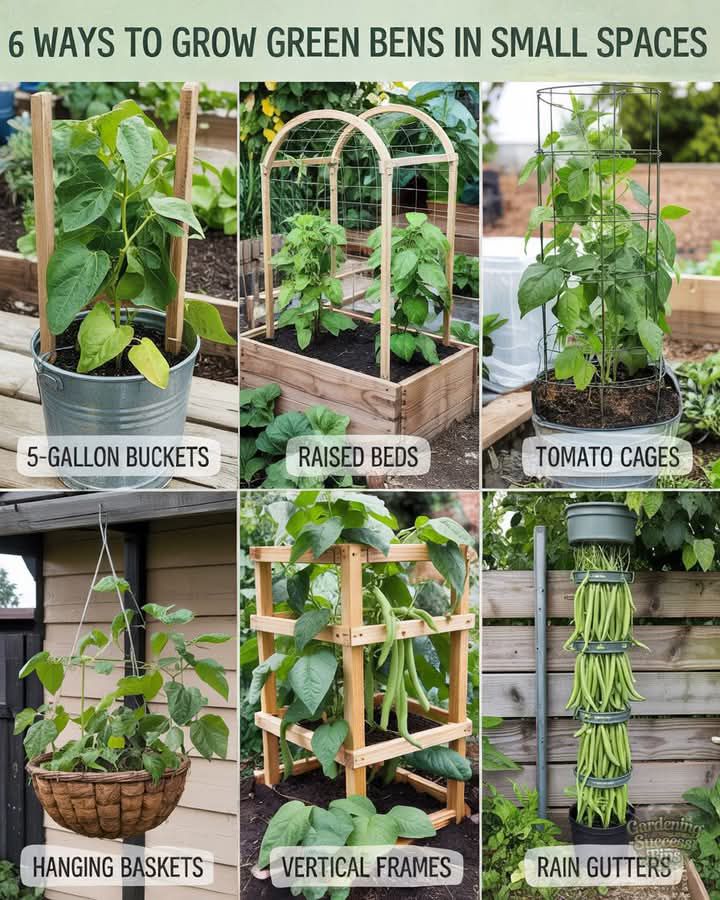Green beans, also known as string beans, snap beans, or green peas, are an excellent choice for gardeners, especially those with limited space. They are fast-growing, easy to care for, and can produce an abundant harvest with relatively low maintenance. Whether you’re gardening in a small backyard, on a balcony, or even in a container garden, green beans can thrive in vertical setups, making them ideal for tight spaces. If you’re looking to grow green beans and maximize your harvest, this comprehensive guide will cover everything from choosing the right variety to soil care, watering, and maintenance. Read on for everything you need to know!
Why Choose Green Beans for Your Garden?
Green beans are a popular vegetable for both novice and experienced gardeners for many reasons:
Space-efficient: They can be grown vertically, meaning you don’t need a lot of horizontal garden space to grow a decent crop. Whether you have a small backyard, a balcony, or just a patch of garden space, green beans are a perfect solution for maximizing limited space.
Low maintenance: Green beans are easy to grow and do not require extensive care. Once planted, they thrive with little attention. Additionally, green beans are nitrogen-fixers, which means they can enrich the soil around them without needing a lot of additional fertilization.
Fast-growing: One of the biggest advantages of growing green beans is how quickly they mature. They are among the fastest-growing plants in a garden, making them perfect for repeated harvests throughout the summer.
Versatile in cooking: Green beans are an incredibly versatile vegetable used in a variety of recipes, from fresh salads to soups, stir-fries, or even as a side dish. Whether you enjoy them raw, steamed, sautéed, or pickled, green beans can complement many dishes.
🌱 Selecting the Right Variety of Green Beans
There are two main types of green beans: bush beans and pole beans. Each type has its benefits and can suit different garden setups, so it’s important to choose the right one for your space and growing conditions.
Bush Beans: These are compact, low-growing plants that typically reach about 12 to 18 inches in height. Bush beans grow quickly, and once they’re mature, they offer a concentrated harvest over a short period. They’re perfect for small gardens or containers because they don’t require any vertical support. Their compact growth also makes them easy to maintain, as you can harvest the beans without needing a ladder or extra equipment. Popular varieties of bush beans include Blue Lake Bush Beans and Provider Beans.
Pole Beans: Pole beans, as the name suggests, require vertical support like trellises, stakes, or poles. These varieties grow tall, often reaching 6 feet or more. Pole beans are ideal for gardeners who want to maximize vertical space. They tend to produce beans over a longer period compared to bush beans, providing a continuous harvest throughout the summer. However, they do require a little more maintenance since you’ll need to set up and support their growing vines. Popular pole bean varieties include Kentucky Wonder, Scarlet Runner Beans, and Stringless Green Pods.
🌞 Choosing the Best Location for Green Beans
Green beans require a sunny spot to thrive. They need at least 6–8 hours of sunlight daily for optimal growth. When choosing where to plant your green beans, consider these factors:
Sunlight: Green beans are sun-loving plants, so they should be planted in a location that receives direct sunlight for most of the day. If you’re planting pole beans, make sure there’s enough vertical space for the vines to climb and that the plants will not be shaded by larger plants.
Soil: Green beans prefer well-draining, light, slightly alkaline soil with a pH of around 6.0–7.0. A soil rich in organic matter, such as compost or well-aged manure, can improve the structure and fertility of your soil. If you’re growing beans in containers, use a potting mix that drains well. Beans don’t like heavy, clay-like soil, which can retain too much moisture and lead to root rot.
Space: Green beans, especially pole beans, can be grown vertically, making them perfect for tight spaces. Use trellises, fences, or poles to support the climbing vines. Make sure to provide at least 6–8 inches of space between each plant to allow for adequate airflow and avoid overcrowding.
💧 Watering Green Beans
Proper watering is key to healthy bean growth. Green beans prefer consistently moist soil, but overwatering can be detrimental. It’s important to strike a balance.
Moist, but not soggy: Water the soil regularly, ensuring it stays moist. The ideal method is to water deeply, allowing the water to reach the root zone, rather than shallow watering, which may encourage shallow roots.
Avoid wet foliage: When watering, try to water the soil and avoid getting water on the leaves. Wet leaves can encourage fungal diseases and mold growth. Consider using a soaker hose or watering at the base of the plant to reduce moisture on the leaves.
Morning watering: The best time to water green beans is in the morning. This ensures the plants get the moisture they need before the heat of the day and reduces the chances of fungal diseases, as the foliage has time to dry out before evening.
🌿 Fertilizing and Soil Care
Green beans are relatively low-maintenance when it comes to fertilization, but they do benefit from healthy, nutrient-rich soil.
Nitrogen-fixing plants: Beans naturally fix their own nitrogen, meaning they have the ability to take nitrogen from the air and convert it into a form the plant can use. This eliminates the need for high-nitrogen fertilizers, which can promote excessive leaf growth at the expense of flowers and beans.
Compost and organic fertilizers: If your soil is poor or lacks nutrients, consider enriching it with compost or organic fertilizers. These additions provide a slow release of nutrients that support strong bean growth without the risk of over-fertilizing.
Mulch: Apply a layer of mulch around the base of your green beans. Mulch helps conserve moisture, keeps weeds at bay, and adds organic matter to the soil as it decomposes. Materials like straw, wood chips, or grass clippings work well for mulch.
✂️ Pruning and Maintenance
While green beans are relatively low-maintenance, pruning and general upkeep can improve their growth.
Prune dead or diseased growth: Regularly remove any dead or damaged foliage to encourage healthy new growth and reduce the risk of pests or disease.
Support for pole beans: Ensure that pole beans have enough vertical support. As the vines grow, gently guide them onto the trellis or support structure, and secure them if necessary. This will help maximize space and ensure the plants grow upright.
🌾 Pest Control
Green beans are susceptible to a few common pests, including aphids, beetles, and caterpillars. While they are relatively pest-resistant, taking a few preventive measures can help protect your plants.
Companion planting: Consider planting companion plants such as marigolds, basil, or garlic near your green beans. These plants naturally repel many garden pests, including aphids and beetles.
Hand-picking pests: If you notice pests on your green beans, remove them by hand or use an insecticidal soap to get rid of them without harming your plants.
Neem oil: A natural and organic pest control solution, neem oil can be used to protect your green beans from pests and fungal diseases.
🌿 Harvesting Green Beans
The best part about growing green beans is the harvest! Here’s how to know when to pick them:
Bush beans: Harvest when the pods are firm and plump but before the seeds inside begin to mature. Picking regularly encourages more beans to grow.
Pole beans: These beans also need to be harvested before the seeds inside the pod become too mature. Pole beans typically produce beans over a longer period, so regular harvesting is important to ensure you’re picking them at their peak.
🌱 Conclusion
Green beans are the perfect addition to any garden, whether you’re working with a small space or an expansive plot. Their quick growth, low maintenance, and ability to thrive in vertical setups make them ideal for gardeners of all levels. With the right care—sunlight, proper soil, watering, and a little love—you’ll enjoy a bountiful harvest of fresh, flavorful green beans all season long. Happy gardening! 🌱
More Articles You Might Like
-
Texas Toast Sloppy Joes: The Crunchy, Cheesy Upgrade You Didn’t Know You Needed
There’s something timeless about sloppy joes. For generations, this saucy, savory, and slightly sweet ground beef sandwich has been a go-to comfort food in American kitchens. It’s quick, filling, and family-friendly—perfect for busy weeknights. But what if we told you there’s a way to take this classic dish up a notch? Enter the Texas Toast…
-
Classic Pig Pickin’ Cake
When it comes to Southern desserts, few sweets shine as brightly as the Classic Pig Pickin’ Cake. This nostalgic cake, sometimes called a “Mandarin Orange Cake,” has roots deep in Southern tradition. It gets its playful name from its frequent appearance at pig pickin’s—Southern-style barbecue gatherings where communities come together to enjoy slow-cooked pork, sides,…
-
Lemon Garlic Butter Chicken with Creamy Parmesan Pasta
There’s something irresistible about the combination of tender, golden-browned chicken paired with a creamy pasta coated in Parmesan cheese. Add the brightness of lemon, the depth of garlic, and the richness of butter, and you have a recipe that feels indulgent yet approachable enough for a weeknight dinner. Lemon Garlic Butter Chicken with Creamy Parmesan…



